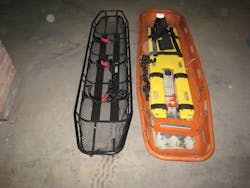Tech Rescue: ROPE RESCUE: Basic Packaging & Lowering Techniques - Part 4
Up to this point, this series has covered a significant amount of information regarding the world of rope rescue; however, we have merely scratched the surface in this technical field. We discussed safety points and considerations, anchoring systems and haul system properties and calculations. Rounding out our spirited discussion will include basic patient packaging systems and getting the patient down from an elevated area.
Safe and efficient patient packaging
When it comes to packaging, there are many options (and opinions) that will work in the rescue situation. However, the question remains: Which one is “the best”? The term “the best” is relative to the situation at hand; meaning it refers to the best way to package the patient, based upon a few points of consideration:
1. Medical/mechanism of injury. Will the patient’s medical concerns allow for the type of packaging that is being considered? Will the retrieval device afford the positioning of the patient’s injuries? Patients who need emergency definitive care must be moved quickly. Most rescuers will agree that the speed of the rescue operation is determined by the severity of the patient’s injuries.
2. Patient size. We must take patients’ physical characteristics into consideration when it comes to moving them. For those of us who provide confined-space rescue services within our communities, I am sure we can agree that our duties in this area require us to become “flexible” for entry. But many of our victims require removal immobilized, and sometimes that pushes the limits of our packaging capabilities. We must be able to package them positioned for efficient removal.
3. Direction of travel. Which way will the patient be moved – horizontally, vertically or a combination of both? Will your equipment allow flexibility for maneuverability and re-positioning?
4. Available packaging equipment. What do you keep in your equipment cache that can move a patient both efficiently and safely? Can the equipment be used in multiple ways to meet the objective of the rescue?
These are simple points to consider, but drive the overall removal of the patient. Generally, patient comfort and security drive the packaging process. My preference is to move the patient in a horizontal position whenever possible, with the patient’s head slightly raised above the legs. There is a tendency for patients to feel like they are falling backwards when lying flat; therefore, the slight elevation of the head end of the packaging device tends to dissipate that sensation.
Additionally, my preference is to utilize two points of contact for the main line and the belay line. For example, the main haul/lower line may be attached to the litter or basket, but the safety line would be attached to the victim via harness or tied in place harnessing system. That way, both lines are not connected to the same device in the event of a system failure.
Packaging the patient
My preference to package the patient for horizontal positioning does not limit my ability to move that patient in a vertical position, but I let some base packaging concepts stabilize the patient as if they will continue to move horizontally.
Step 1. Start with a backboard with a 30-foot piece of webbing tied in a loop with a water knot. Place the backboard within the loop with the webbing evenly spaced at both sides.
Step 2. Align the victim onto the backboard so the webbing is in the vicinity of the patient’s waist and thigh area.
Step 3. Allow a loop of webbing to be raised between the patient’s thighs.
Step 4. Pull the bottom strand of webbing through the midsection handle of the backboard and thread that bight of webbing through the loop at the patient’s waist.
Step 5. Place the patient’s arms through the bight of webbing, and secure the webbing loop to the top of the backboard.
Step 6. Place the patient and the backboard into the removal device of choice and secure the patient inside the device.
Step 7.Utilizing approved equipment; prepare to connect the main line and the belay line to the patient. Be sure to attach a tag line to the device as well to aid in controlling the movement of the patient during the operation.
Making the connection
Once packaged, the main line and the belay line are connected. The question becomes one of victim positioning during movement; again, my preference is horizontal, but there may be reasons that require vertical positioning during travel. All things considered, my preference takes both into account.
Initially, my connections should grab four points of contact onto the device; two at the head side and two at the foot side. Devices such as slings, straps and pre-tied harnesses are available to rescue teams. These devices are point-adjustable and can be used in a variety of applications and settings. They do come with a price in terms of associated hardware and equipment. If your rescue cache is lacking in equipment, bridle systems can certainly use up a large portion of resources.
Connection points can also be made with the main line itself, and a common knot for such a connection is the French Bowline. One advantage of the French Bowline is that it uses virtually no hardware to make the connections; however, it can slip through the device when loaded and cause the patient to change positions during lowering.
For the belay line, a pre-sewn harness that can be utilized on the patient is a primary choice. One main point of consideration; can the device be applied to the patient without compromising patient care? It may be necessary to utilize a harness or connection system that can be modified based upon the condition of the patient. Once attached, the belay line can be attached to this device at a safe point, based upon the position of travel. Keep in mind that, in the event the belay system becomes loaded, it should not have an adverse effect on overall patient condition.
Lowering systems
For our discussion, we will stick to single-person loads (non-attended litters). There are many devices that work well for this application and rescuers are limited only by their ability to utilize the equipment – 8 Plates, Racks Friction Belays and other devices all have their advantages and shortfalls, and each company should experiment with what works for their specific needs. Most importantly, try a few different devices before committing to one way of lowering a victim; make sure your members are comfortable with the capabilities of the device.
Patient packaging and removal operations should be practiced regularly. It can be achieved at the fire station, and can help to hone these skills when the emergency occurs. Company members should be comfortable with the types of devices that their department uses so the operation goes safely and efficient. The transition for the patient to go from the site of injury to the transport location should be a smooth, fluid transition; when the patient is in transit, it is not the time for shortcomings in skill and abilities.
Conclusion
This is just an introduction on the surface of a very technical area of expertise when it comes to technical rescue. It has been my intention over this series of articles to restore the spark within the rescuer to re-visit the use of rope in the world of emergency response, and how each of us can benefit from a strong level of understanding in abilities and limitations.
Statistics show that the potential for these incidents to occur is nationwide, and we owe it to the customers we serve to be able to handle any time of emergency, at any time, at any location. After all, that is why they call us.
For more news and training on rescue and special operations, visit: http://www.firehouse.com/topics/rescue-special-ops.
MIKE DALEY is a lieutenant and training officer with Monroe Township, NJ, Fire District 3 and an instructor at the Middlesex County Fire Academy, responsible for Fire and Rescue Training Curriculum development. Daley also is a rescue officer with the New Jersey Task Force 1 – Urban Search and Rescue team. He holds certifications as Rescue Technician, Incident Safety Officer, Hazardous Materials Specialist and On-Scene Incident Commander, EMT, Level II Fire Instructor, SCBA/Smokehouse and Live Burn Instructor, Fire Inspector, and Fire Officer. Daley holds degrees in business management and public safety administration. He is the founder and senior consultant for Fire Service Performance Concepts.
Connect with Mike
Twitter: @FSPCEducators

Michael Daley
MICHAEL DALEY, who is a Firehouse contributing editor, is a 37-year veteran who serves as a captain and department training officer in Monroe Township, NJ. He is a staff instructor at multiple New Jersey fire academies and is an adjunct professor in the Fire Science Program at Middlesex County College. Daley is a nationally known instructor who has presented at multiple conferences, including Firehouse Expo and Firehouse World. His education includes accreditations as a Chief Training Officer and a Fire Investigator, and he completed the Craftsman Level of education with Project Kill the Flashover. Daley is a member of the Institution of Fire Engineers and a FEMA Instructor and Rescue Officer with NJ Urban Search and Rescue Task Force 1. He operates Fire Service Performance Concepts, which is a training and research firm that delivers and develops training courses in many fire service competencies.






